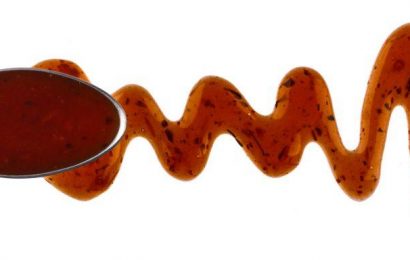If you have been following the recent media coverage of fructose and high-fructose corn syrup, chances are good that you are confused by the often contradictory reports about these sweeteners. On the one hand, studies warning of their negative effects on health seem to be flooding magazines, television, and newspapers. On the other hand, reports attesting to the safety of these popular sweeteners are also common. What is the truth about fructose and high-fructose corn syrup? Are they safe, or are they potentially harmful to our health?
To add to the confusion, high-fructose corn syrup is not really high in fructose at all compared with other common sweeteners. In fact, it has about the same proportions of fructose and glucose as table sugar (sucrose). Many other sweeteners – including honey, maple syrup, and molasses – contain both fructose and glucose in varying proportions.
To understand the debate surrounding fructose and high-fructose corn syrup, it’s important to understand what they are, where they are found, and how our bodies break them down.
What is fructose?
Fructose is a monosaccharide, or simple sugar, which means that its basic structure consists of six carbon atoms joined in a ring. Like other dietary sugars, fructose provides about 15 calories per teaspoon and is digested in and absorbed from the small intestine. However, there are important differences in the way fructose is handled by the body compared with other sugars.
The two main dietary sources of fructose are fruits, where it is found in high concentrations (hence its common name, “fruit sugar”); and sucrose, or table sugar, which is formed by the combination of equal amounts of fructose and glucose. Fructose is also found in honey, maple syrup, agave syrup, brown rice syrup, and in small amounts in a scattering of vegetables.
In addition, fructose is present in the commercially prepared liquid sweetener known as high-fructose corn syrup, or HFCS. High-fructose corn syrup is formed by a complex process in which corn is first processed into cornstarch, which is then treated with enzymes to form corn syrup. “High-fructose” is used in the title to differentiate the product from regular corn syrup, which is mostly glucose. Because it is inexpensive, mixes well with other ingredients, and helps keep foods moist, high-fructose corn syrup is widely used by the food industry as an alternative to sucrose in many processed and prepared foods and beverages. There are two common types of high-fructose corn syrup now used in the United States: HFCS 55, which is 55% fructose and 42% glucose and is used mostly in soft drinks, fruit juice blends, and other beverages; and HFCS 42, which is 42% fructose and 53% glucose and is used in yogurt, baked goods, frozen desserts, breakfast cereals, and other prepared foods.
Glucose, another simple sugar, is the body’s main fuel source and is readily burned for energy. This is because glucose is carried into cells throughout the body by the hormone insulin, which also regulates the level of glucose in the blood. Fructose, on the other hand, is not easily used by the body for fuel. It is not transported into cells by insulin; instead, fructose is taken from the small intestine to the liver by a special carrier protein known as GLUT-2. Once inside the liver, fructose undergoes a number of complex biochemical reactions that can lead to the formation of a number of different compounds, including glycogen (a stored form of glucose), triglycerides (a type of fat found in the blood, often linked to weight gain and obesity), and some types of fatty acids. Fructose may also be converted to the chemical uric acid, which in high levels may stress the kidneys and other organs, thereby increasing the risk of developing gout, kidney stones, and other chronic conditions. This fundamental difference in the way fructose is handled by the body, compared with glucose, has made it the target of studies exploring its possible ill effects on health.
During the past decade, fructose-containing sweeteners have been linked to numerous health problems, including obesity, hypertension, elevated blood triglycerides and LDL (low-density lipoprotein, or “bad”) cholesterol, and insulin resistance – suggesting that fructose may play a role in the development of atherosclerosis, metabolic syndrome, and diabetes. Another possible negative effect of high fructose consumption is its potential role in the onset of nonalcoholic fatty liver disease. The following sections describe some of the findings of studies that looked at the role of fructose in various health conditions.
Obesity
One of the most hotly contested topics related to fructose is its potential role in the development of obesity. Consuming a large amount of fructose is known to raise the level of triglycerides in the blood; elevated triglycerides are often seen in obese individuals. Some researchers believe that high levels of dietary fructose contribute to weight gain by stimulating the deposit of triglycerides in fat tissue throughout the body.
The fructose—triglyceride connection was explored in a small clinical study conducted at the University of Texas, published in 2008, in which six healthy volunteers were fed one of three different breakfast drinks daily, with the drink chosen at random. The three drinks were sweetened, respectively, with 100% glucose, 50% each glucose and fructose, and 25% glucose and 75% fructose. Levels of blood triglycerides were found to be 200% higher following ingestion of a beverage containing fructose, compared with the glucose- only beverage.
Other studies have yielded similar results, including one conducted at the University of Pennsylvania that enrolled 12 normal-weight women. Significantly higher levels of triglycerides were seen after just one day among those randomly chosen to drink 25% of their daily calories from a fructose-sweetened beverage, compared with the remaining women, who drank a glucose-sweetened beverage. Women who drank the fructose-sweetened beverage also displayed significantly lower levels of leptin and higher levels of ghrelin – two hormones associated positively and negatively, respectively, with appetite control. An imbalance of these hormones is believed to play a role in obesity in many individuals.
In a study conducted at the University of Toronto, scientists looked at how drinking beverages with different ratios of glucose to fructose affected participants’ intake of food later on; a total of 31 men took part. The researchers found that the men’s food intake was lower after they drank high-glucose rather than high-fructose beverages. Drinking high-fructose beverages also led to higher blood levels of potentially harmful uric acid.
Hypertension
Two recently published studies show that a moderate to high intake of fructose may be linked to an increased risk of hypertension – possibly by causing the kidneys to absorb extra water and sodium. Dietary and health information collected from 4,528 healthy adults through the National Health and Nutrition Examination Survey (NHANES 2003—2006) showed that consumption of more than the average of 74 grams per day of fructose (equivalent to about 2 1/2 servings of soft drinks) led to a 77% higher risk of blood pressure elevated to 160/100 mm Hg or higher, compared with a normal reading of 120/80 mm Hg.
And in a small clinical trial conducted at the Mateu Orfila Hospital in Spain, researchers fed 74 healthy men 200 grams of supplemental fructose a day (about 3—4 times the amount most people get in their diets) for two weeks. In addition, half of the men received allopurinol, a medicine used to lower blood levels of uric acid and relieve the painful symptoms of gout. At the end of the study, both blood pressure and uric acid levels were significantly higher in men who did not receive the allopurinol.
Blood lipids, glucose, and insulin
Other studies have looked at levels of blood lipids, glucose, and insulin in relation to fructose intake. In 2010 researchers at the University of California followed 23 overweight and obese adults, aged 43—70, for 10 weeks to measure the effects of drinking sugar-sweetened beverages. Participants were randomly assigned to consume 25% of their total calories from either glucose- or fructose-sweetened beverages (about 3 servings per day). At the end of the 10 weeks, participants who had drunk the fructose-sweetened beverages showed significantly higher levels of blood triglycerides and LDL cholesterol, as well as greater abdominal adipose (fat) tissue. They also had higher fasting blood glucose and insulin levels. In contrast, consuming the glucose-sweetened drinks had little or no effect on these measures.
Similar results were seen in a French study in which 16 healthy participants with a family history of Type 2 diabetes (but without diabetes themselves) consumed 35% of their calories from fructose-sweetened drinks for one week. At the end of the study, these participants showed an increase in abdominal fat, reduced insulin sensitivity, and higher levels of blood triglycerides – to a greater degree than did a control group of eight people with no family history of diabetes, who received the same treatment.
Nonalcoholic fatty liver disease
Another concern about fructose is its possible role in the development of nonalcoholic fatty liver disease (NAFLD), a liver disorder that is more common in people with Type 2 diabetes than in the general population. NAFLD is marked by a buildup of fat in the liver that causes inflammation and scarring, sometimes leading to liver failure. Fructose, research suggests, may contribute to the onset of NAFLD by way of its conversion to triglycerides in the liver.
In a study of 427 adults conducted at Duke University in 2010, consuming more than seven fructose-sweetened beverages per week was linked to a greater degree of a type of liver damage called fibrosis. In participants ages 48 and up, fructose intake was also associated with greater inflammation of the liver. The scientists conducting the study concluded that habitual consumption of fructose may lead to liver damage and set the stage for chronic liver disease.
Conflicting results
Not all studies, however, paint as negative a picture of fructose and HFCS as the ones described above. Some researchers have found no connection between fructose intake and various health-related measures. Among participants in three large national studies of diet and disease risk, fructose from sweetened sodas, fruit juices, and fruit was not linked to high blood pressure, according to a 2008 analysis. In a separate study, Dutch researchers compared the effects of drinking four different beverages (milk, an artificially sweetened “diet” drink, and beverages sweetened with either high-fructose corn syrup or a glucose—sucrose blend) on hunger, as measured by how much of a yogurt—granola preparation participants ate afterward (40 healthy adults took part). Participants ate more after the diet drink, but there was no significant difference among the other beverages.
Finally, a study of 30 lean women conducted at the University of Rhode Island that measured blood glucose and insulin levels after consumption of beverages found no difference between those sweetened with HFCS and those sweetened with sucrose. There was also no difference in the resulting levels of the hormones ghrelin or leptin. This result does not directly contradict the University of Pennsylvania study, which found differences between beverages sweetened with pure glucose and pure fructose. However, it’s interesting to note that in this study, drinking a sucrose-sweetened beverage was associated with a higher desire to eat the next day, compared with drinking a HFCS-sweetened beverage.
Not surprisingly, the conflicting results from these studies have set off a heated debate among scientists over the safety of fructose-containing sweeteners. Some researchers believe that the difference in the way the body handles glucose and fructose is responsible for many of the negative effects associated with fructose. As noted earlier, fructose is not absorbed into fat, muscle, and other body cells from the bloodstream but instead goes to the liver, where it forms triglycerides and LDL cholesterol. These lipids then enter the bloodstream, where they may trigger complex processes that make the body less sensitive to insulin and set the stage for the development of diabetes and other disorders.
Other scientists are skeptical of findings that suggest negative effects from fructose on blood pressure, weight control, and blood lipid levels. They note that most of the data supporting these findings are from studies with a short duration and a very small sample size. Some suggest that errors in measurement of triglycerides and body fat could have led to misleading or inaccurate results. Skeptical researchers also doubt that the unique properties of fructose can explain the tremendous rise in obesity and related health conditions in the United States in recent years.
Questions raised
Needless to say, the contradictory and sometimes confusing data presented by these studies raise a number of questions. One pattern seen across these studies is that while obese people tended to experience negative effects from fructose on blood pressure, blood lipid levels, and appetite, lean and healthy people often did not. It might therefore be useful to further explore the role that genes and family history play in shaping reactions to fructose-containing sweeteners.
Another important point about these studies is that they looked at many different forms of fructose. Although many examined high-fructose corn syrup in beverages, others used prepared solutions containing varying percentages of fructose. As a result, these studies put very different questions to the test, such as: Is HFCS worse for the body than table sugar? Is fructose worse than glucose? What happens when extra fructose is simply added to the diet?
To understand the possible role that fructose and HFCS play in the development of obesity and related diseases, it will be important for future studies to ask a clear question and then choose their participants and methods accordingly.
Limiting all sugars
In light of the studies conducted to date, most scientists agree that there is currently no convincing evidence of a direct link between HFCS and obesity or other health problems. The consensus, instead, is that the real culprit appears to be consumption of too many calories from all food sources. Americans’ high intake of all types of sugar and other refined carbohydrates, in particular, may be the main driver of obesity and other chronic health problems.
Recognition of the role of sugar in the development of obesity has prompted the US Department of Agriculture (USDA) to make recommendations about sugar consumption. As part of its Dietary Guidelines for Americans, 2010, the agency’s Center for Nutrition Policy and Promotion urges everyone to choose foods and beverages with few added sugars. Because added sugars are not listed separately from total sugars on product labels, the guidelines also encourage consumers to check the ingredients list on labels for sources of added sugar.
The American Heart Association goes even further in its recommendations for added sugar intake: It advises men to limit their consumption to 150 calories a day (about 9 teaspoons of sugar), and women to limit theirs to 100 calories a day (about 6 teaspoons of sugar).
Americans currently ingest an astonishing 130 pounds of sugar a year, or an average of 38 teaspoons each day, so meeting these recommendations on a nationwide level will be difficult. On an individual level, dietary changes are best accomplished gradually over time – and cutting back on added sugars is no exception. Here are some tips to get you started:
• The USDA estimates that a whopping 36% of added sugars consumed by Americans comes from soda, energy drinks, and sports drinks. If you drink regular (not diet) sweetened beverages, scale back or eliminate them from your diet to cut down on added sugar.
• Check ingredients lists on product packages for added sugars, including sucrose, dextrose, maltose, xylose, invert sugar, honey, molasses, fruit juice concentrate, maltodextrin, turbinado sugar, malt syrup, brown rice syrup, agave nectar – and, of course, high-fructose corn syrup. If the product contains more than two or three types of sugar, it likely contains a lot of added sugar, and you may want to consider putting it back on the shelf.
• Buy 100% fruit juice instead of fruit drinks with added sweeteners. But still keep your portions small: Depending on what kind of fruit it contains, one cup of 100% fruit juice provides 100—200 calories and 20—45 grams of carbohydrate.
• Cut the amount of sugar you use in baking and cooking. You can often cut the sugar in recipes by one-quarter to one-third with no loss of quality in the end product.
• Skip or share dessert more often. About 13% of added sugars in the American diet comes from pies, cookies, and cakes.




